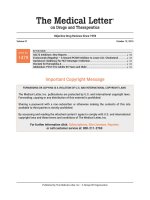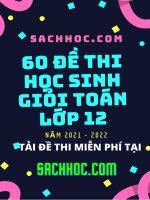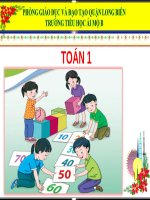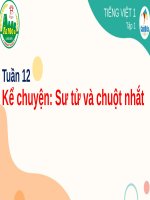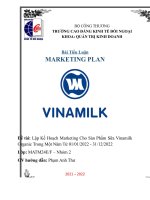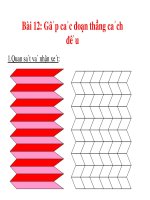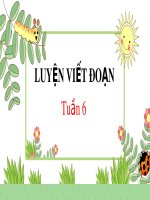2022 october 12 psat
Bạn đang xem bản rút gọn của tài liệu. Xem và tải ngay bản đầy đủ của tài liệu tại đây (3.79 MB, 58 trang )
PSAT/NSMQT
October 12, 2022
US Administration
© 2016 The College Board. College Board, SAT, and the acorn logo are registered trademarks of the College Board.
1
1
Reading Test
60 MINUTES, 47 QUESTIONS
Turn to Section 1 of your answer sheet to answer the questions in this section.
Each passage or pair of passages below is followed by a number of questions. After reading
each passage or pair, choose the best answer to each question based on what is stated or
implied in the passage or passages and in any accompanying graphics (such as a table or
graph).
This passage is adapted from Edith Wharton, “Writing a War
Story.” Originally published in 1919.
Line
5
10
15
20
25
She, Ivy Spang, of Cornwall-on-Hudson, had been
asked to write a war story for the opening number of
“The Man-at-Arms,” to which Queens and
Archbishops and Field Marshals were to contribute
poetry and photographs and patriotic sentiment in
autograph! And her full-length photograph in nurse’s
dress was to precede her prose; and in the table of
contents she was to figure as “Ivy Spang, author of
Vibrations: A Book of Verse.”
She was dizzy with triumph, and went off to hide
her exultation in a quiet corner of Brittany, where she
happened to have an old governess, who took her in
and promised to defend at all costs the sacredness of
her mornings—for Ivy knew that the morning hours of
great authors were always “sacred.”
She shut herself up in her room with a ream of
mauve paper, and began to think.
At first the process was less exhilarating than she
had expected. She knew so much about the war that
she hardly knew where to begin; she found herself
suffering from a plethora of impressions.
Moreover, the more she thought of the matter, the
less she seemed to understand how a war story—or any
story, for that matter—was written. Why did stories
ever begin, and why did they ever leave off? Life didn’t
—it just went on and on.
This unforeseen problem troubled her exceedingly,
and on the second morning she stealthily broke from
her seclusion and slipped out for a walk on the beach.
Unauthorized copying or reuse of any part of this page is illegal.
.......................................................................................................................................................................................................
Questions 1-9 are based on the following passage.
2
30
35
40
45
50
55
60
She had been ashamed to make known her projected
escapade, and went alone, leaving her faithful
governess to mount guard on her threshold while she
sneaked out by a back way.
There were plenty of people on the beach, and
among them some whom she knew; but she dared not
join them lest they should frighten away her
“Inspiration.” She knew that “Inspirations” were fussy
and contrarious, and she felt rather as if she were
dragging along a reluctant dog on a string.
“If you wanted to stay indoors, why didn’t you say
so?” she grumbled to it. But the Inspiration continued
to sulk.
She wandered about under the cliff till she came to
an empty bench, where she sat down and gazed at the
sea. After a while her eyes were dazzled by the light,
and she turned them toward the bench and saw lying
on it a battered magazine—the midsummer “AllStory” number of “Fact and Fiction.” Ivy pounced
upon it.
She had heard a good deal about not allowing one’s
self to be “influenced,” about jealously guarding one’s
originality, and so forth. But her story had to be
written, and she didn’t know how to begin it; so she
decided just to glance casually at a few beginnings.
The first tale in the magazine was signed by a name
great in fiction, one of the most famous names of the
past generation of novelists. The opening sentence ran:
“In the month of October, 1914—” and Ivy turned the
page impatiently. She may not have known much
about story-writing, but she did know that that kind of
a beginning was played out. She turned to the next.
“‘My God!’ roared the engineer, tightening his grasp
CO NTI N U E
1
70
75
80
85
90
1
As used in line 8 “figure” most nearly means
A) appear.
B) form.
C) reason.
D) calculate.
Unauthorized copying or reuse of any part of this page is illegal.
...............................................................................................................................................................................................................................................................................................................
65
on the lever, while the white, sneering face under the
red lamp . . .”
No; that was beginning to be out of date, too.
“They sat there and stared at it in silence. Neither
spoke; but the woman’s heart ticked like a watch.”
That was better; but best of all she liked: “Lee
Lorimer leaned to him across the flowers. She had
always known that this was coming . . .” Ivy could
imagine tying a story on to that.
But she had promised to write a war story; and in a
war story the flowers must be at the end and not at the
beginning.
At any rate, there was one clear conclusion to be
drawn from the successive study of all these opening
paragraphs; and that was that you must begin in the
middle, and take for granted that your reader knew
what you were talking about.
Yes; but where was the middle, and how could your
reader know what you were talking about when you
didn’t know yourself?
After some reflection, and more furtive scrutiny of
“Fact and Fiction,” the puzzled authoress decided that
perhaps, if you pretended hard enough that you knew
what your story was about, you might end by finding
out toward the last page. “After all, if the reader can
pretend, the author ought to be able to,” she reflected.
And she decided (after a cautious glance over her
shoulder) to steal the magazine and take it home with
her for private dissection.
1
3
2
The passage indicates that when Ivy begins to work
on the story she feels
A) overwhelmed, because she finds it difficult to
organize her ideas.
B) discouraged, because her deadline for
completing the story is approaching.
C) excited, because her work will be featured with
that of royalty.
D) inspired, because she is able to spend time by
the ocean.
3
It can reasonably be inferred from the passage that
one realization Ivy comes to about stories is that
A) the best ones are typically written in a few days.
B) there is a skill to writing them that she is
incapable of learning.
C) there is an artificiality to them that she had not
anticipated.
D) they must address issues relevant to a particular
historical time.
4
Which choice provides the best evidence for the
answer to the previous question?
A) line 22-24 (“Moreover . . . written”)
B) line 24-26(“Why did . . . and on”)
C) line 55-57 (“The first . . . novelists”)
D) line 89-91 (“And she . . . dissection”)
CO NTI N U E
1
In the context of the passage, the sentence in line
37-39 (“She knew . . . string”) mainly serves to
emphasize Ivy’s
A) frustrations with the crafting of her story.
B) dilemma about accepting her assignment.
C) obstacles in writing for a popular audience.
D) distress about her lack of literary fame.
6
The use of “pounced” in line 48-49 has the main
effect of suggesting Ivy’s
A) deceptiveness.
B) eagerness.
C) physical agility.
D) crude manners.
Unauthorized copying or reuse of any part of this page is illegal.
...............................................................................................................................................................................................................................................................................................................
5
1
4
7
Ivy criticizes the opening sentences of the first two
stories in the magazine because they
A) are overly dramatic and sentimental.
B) represent the work of inexperienced writers.
C) lack specific details.
D) are unoriginal and old-fashioned.
CO NTI N U E
1
The passage most strongly suggests that Ivy reaches
which conclusion about the writing of fiction?
A) It might involve a level of uncertainty that she
had failed to consider previously.
B) It can be facilitated by imitating the language of
successful authors whom she admires.
C) It is a creative undertaking that must reflect the
beauty of nature.
D) It is a secretive process that can be
communicated to only a select few.
Unauthorized copying or reuse of any part of this page is illegal.
...............................................................................................................................................................................................................................................................................................................
8
1
5
9
Which choice provides the best evidence for the
answer to the previous question?
A) line 40-42 (“If you . . . sulk”)
B) line 52-54 (“But her . . . beginnings”)
C) line 80-82 (“Yes . . . yourself”)
D) line 83-87 (“After . . . page”)
CO NTI N U E
1
Passage 1 is adapted from Erica Whyman, “Should the Arts
Get Public Money? Yes.” ©2011 by BBC. Passage 2 is adapted
from David John Marotta, “Public Funding for the Arts.”
©2012 by Forbes Media LLC.
Line
5
10
15
20
25
30
35
40
Passage 1
I am convinced that the arts are a significant public
good, that civic well-being is damaged when the arts
are unsupported [by public funding] and, while they
make an important economic contribution, their
profitability is not a sufficient measure of their quality
or their success.
I am increasingly uncomfortable with the economic
argument, because it suggests that only activities
which generate economic growth are deserving of
public investment. Caring for the elderly, for instance,
would fail this test.
However, it is worth repeating that public money
spent on the arts has a proven tendency to turn into
money spent elsewhere: on hotel rooms, restaurants,
production supplies and, most importantly, jobs.
In Newcastle and Gateshead, every £1 of public
investment in the 10 main cultural buildings results in
£5 generated by the regional economy, according to
the Treasury’s own calculations, not least because
between us we employ over 2000 people. . . .
Not everyone in this country grows up thinking the
arts are for them. Artists and educators are and should
be obliged to create opportunities for people from all
backgrounds to encounter the very best artistic
experiences.
When we do this well, the results are staggering—
individual confidence soars and life chances are
radically improved.
One example: last year we made a show called
Apples, an exhilarating account of growing up in
Middlesbrough. . . .
I’d like opponents of arts funding to ask themselves
what it might feel like to be 15 in Middlesbrough and
to find out there is a play on, in your home town, and
it’s about you.
The play toured all over the country and went on to
win an award in Edinburgh. If our audience had had
to pay all the costs of making the show (the modest
£400 a week we pay our highly skilled actors, for
instance) we would have had to charge £35 a ticket.
Could those young people have come at that price?
The market says no. Should they make a contribution,
appropriate to their income? I think so, yes.
Unauthorized copying or reuse of any part of this page is illegal.
...............................................................................................................................................................................................................................................................................................................
Questions 10-18 are based on the following
passages.
1
6
45
50
55
60
65
70
75
80
85
So for around the price of a cinema ticket, they saw
themselves represented on stage and were provoked,
entertained and moved. They may even have been
turned on to the theatre. They certainly felt less
invisible, more significant, better understood.
The arts have always been able to make a society not
just “Big” but cohesive, intelligent and better equipped
to speak its mind. It is dangerous, ignorant and
churlish to endanger them.
Passage 2
Emotionally the choice is presented as saving the
arts or cutting them. However the arts are not in
question. The issue is government funding of the arts.
Should we take money from the most productive forces
in the economy to subsidize certain artists chosen by
committee?
Supporters claim that subsidizing the arts pays for
itself. They suggest that the arts drive the economics of
businesses within a community.
There are two problems with this idea. First, if the
art is commercial, it is already being funded. And if the
art is justified by supporting other businesses, it is also
being funded. To the extent a coffee shop can increase
its traffic via art exhibits, musical offerings or poetry
readings, it is already encouraging artists to perform.
Second is the unseen cost of taking money from the
economy that could be used for other purposes.
Because of our progressive tax code, the marginal
burden of subsidizing art falls largely on the highest tax
brackets populated by small business owners and
entrepreneurs. This group is the most productive at
putting money to work. . . .
We often hear an anecdote about a brilliant artist
recognized by the arts community who isn’t yet
successful commercially. This situation is perceived as
tragic, demanding action like providing the artist with
a government subsidy. But there [is a] difficult[y] with
this point of view.
. . . [T]here is no guarantee that government funding
would offer faster recognition than crowd sourcing.
Production and distribution costs for art have dropped
to a fraction of what they used to be. Without this
barrier to competition, more people are willing to share
their art for little more than the joy of being
recognized. What is lacking is no longer a funding
issue but rather sufficient demand for all the art being
produced. . . .
CO NTI N U E
1
On what basis can we say an artist should get paid
more than society is actually willing to pay? . . . And
what measure of the value of art to society do we have
except the value society is willing to pay for it?
10
As used in line 26, “staggering” most nearly means
A) confusing.
B) astonishing.
C) distressing.
D) unpredictable.
11
Based on Passage 1, Whyman would probably agree
that when making decisions about funding artistic
projects, public officials should prioritize projects
that
A) are likely to increase patronage of local
businesses.
B) impart an uplifting message.
C) are likely to resonate with audiences.
D) are relatively inexpensive to execute.
12
Which choice provides the best evidence for the
answer to the previous question?
A) line 1-6 (“I am . . . success”)
B) line 16-20 (“In Newcastle . . . people”)
C) line 36-40 (“The play . . . ticket”)
D) line 44-47 (“So for . . . theatre”)
Unauthorized copying or reuse of any part of this page is illegal.
...............................................................................................................................................................................................................................................................................................................
90
1
7
13
As used in line 60, “drive” most nearly means
A) pressure.
B) operate.
C) hasten.
D) stimulate.
14
The author of Passage 2 includes the anecdote in
line 75-79 (“We often . . . subsidy”) mainly for the
purpose of
A) emphasizing that a particular problem
discussed in the passage is unlikely to be
resolved.
B) presenting a line of thinking that is ultimately
debunked in the passage.
C) conceding that subsidies for artists may be
justified in certain circumstances.
D) suggesting that the struggles faced by artists
have been exaggerated.
CO NTI N U E
1
Which choice best describes the relationship
between the passages?
A) Passage 2 provides context for an argument put
forth in Passage 1.
B) Passage 2 refutes the primary claim made in
Passage 1.
C) Passage 2 challenges the cultural relevance of
the discussion in Passage 1.
D) Passage 2 questions the motives of the author of
Passage 1.
16
Based on the passages, the author of Passage 1
would most likely disagree with which assumption
made by the author of Passage 2?
A) Some artists are recognized as talented before
they succeed financially.
B) Art can serve to increase a nation’s economic
activity in general.
C) The market value of art indicates art’s value to
society.
D) Crowdsourcing can be an effective way for
artists to gain recognition.
Unauthorized copying or reuse of any part of this page is illegal.
...............................................................................................................................................................................................................................................................................................................
15
1
8
17
It can most reasonably be inferred from the passages
that the author of Passage 2 would likely object to
the claim made in line 12-15, Passage 1
(“However . . . jobs”), on the grounds that
A) since market forces determine which businesses
thrive, it is unrealistic to assume that the arts
influence the success of businesses.
B) since fewer and fewer people are interested in
the arts, the arts are unlikely to produce income
for businesses even with government aid.
C) although the arts currently generate revenue,
they may not necessarily generate revenue in
the future as they lessen in importance.
D) if the arts benefit businesses, then businesses
will support the arts without the need for
government subsidies.
18
Which choice provides the best evidence for the
answer to the previous question?
A) line 59-61 (“Supporters . . . community”)
B) line 62-63 (“First . . . also being funded”)
C) line 68-69 (“Second . . . purposes”)
D) line 83-84 (“Production . . . to be”)
CO NTI N U E
1
This passage is adapted from David L. Chandler, “System
Draws Power from Daily Temperature Swings.” ©2018 by the
Massachusetts Institute of Technology.
Line
5
10
15
20
25
30
35
40
Thermoelectric devices, which can generate power
when one side of the device is a different temperature
from the other, have been the subject of much research
in recent years. Now, a team at MIT has come up with
a novel way to convert temperature fluctuations into
electrical power. Instead of requiring two different
temperature inputs at the same time, the new system
takes advantage of the swings in ambient temperature
that occur during the day-night cycle.
The new system, called a thermal resonator, could
enable continuous, years-long operation of remote
sensing systems, for example, without requiring other
power sources or batteries, the researchers say.
The findings are being reported by Anton Cottrill,
Michael Strano, and seven others in MIT’s Department
of Chemical Engineering.
“We basically invented this concept out of whole
cloth,” Strano says. “We’ve built the first thermal
resonator. It’s something that can sit on a desk and
generate energy out of what seems like nothing. We are
surrounded by temperature fluctuations of all different
frequencies all of the time. These are an untapped
source of energy.”
While the power levels generated by the new system
so far are modest, the advantage of the thermal
resonator is that it does not need direct sunlight; it
generates energy from ambient temperature changes,
even in the shade. That means it is unaffected by shortterm changes in cloud cover, wind conditions, or other
environmental conditions, and can be located
anywhere that’s convenient—even underneath a solar
panel, in perpetual shadow, where it could even allow
the solar panel to be more efficient by drawing away
waste heat, the researchers say.
The researchers realized that to produce power
from temperature cycles, they needed a material that is
optimized for a little-recognized characteristic called
thermal effusivity—a property that describes how
readily the material can draw heat from its
surroundings or release it. Thermal effusivity combines
the properties of thermal conduction (how rapidly heat
can propagate through a material) and thermal
capacity (how much heat can be stored in a given
volume of material). In most materials, if one of these
Unauthorized copying or reuse of any part of this page is illegal.
...............................................................................................................................................................................................................................................................................................................
Questions 19-27 are based on the following passage
and supplementary material.
1
9
45
50
55
60
65
70
75
properties is high, the other tends to be low. Ceramics,
for example, have high thermal capacity but low
conduction.
To get around this, the team created a carefully
tailored combination of materials. The basic structure
is a metal foam, made of copper or nickel, which is
then coated with a layer of graphene to provide even
greater thermal conductivity. Then, the foam is
infused with a kind of wax called octadecane, a phasechange material, which changes between solid and
liquid within a particular range of temperatures
chosen for a given application.
A sample of the material made to test the concept
showed that, simply in response to a 10-degreeCelsius temperature difference between night and day,
the tiny sample of material produced 350 millivolts of
potential and 1.3 milliwatts of power—enough to
power simple, small environmental sensors or
communications systems.
“The phase-change material stores the heat,” says
Cottrill, the study’s lead author, “and the graphene
gives you very fast conduction” when it comes time to
use that heat to produce an electric current.
Essentially, Strano explains, one side of the device
captures heat, which then slowly radiates through to
the other side. One side always lags behind the other
as the system tries to reach equilibrium. This
perpetual difference between the two sides can then be
harvested through conventional thermoelectrics. The
combination of the three materials—metal foam,
graphene, and octadecane—makes it “the highest
thermal effusivity material in the literature to date,”
Strano says.
CO NTI N U E
1
Figure 2
Figures adapted from Anton L. Cottrill et al., “Ultra-High
Thermal Effusivity Materials for Resonant Ambient Thermal
Energy Harvesting.” ©2018 by Anton L. Cottrill et al.
Unauthorized copying or reuse of any part of this page is illegal.
...............................................................................................................................................................................................................................................................................................................
Figure 1
1
10
19
The main purpose of the passage is to
A) highlight the potential drawbacks of a recent
invention.
B) underscore the urgency for research in a
specific field.
C) provide an overview of a well-known process.
D) discuss the significance of a new finding.
20
Which choice best supports the idea that, in
addition to generating power, thermal resonators
can have indirect benefits?
A) line 4-6 (“Now . . . power”)
B) line 17-20 (“We basically . . . nothing”)
C) line 28-34 (“That . . . say”)
D) line 35-40 (“The researchers . . . release it”)
CO NTI N U E
1
According to the passage, with regard to thermal
effusivity, materials are generally
A) more effective at conducting heat than they are
at storing heat.
B) more effective at storing heat than they are at
conducting heat.
C) equally effective at storing and conducting heat.
D) unable to effectively store and conduct heat
simultaneously.
22
As used in line 49, “tailored” most nearly means
A) reconciled.
B) constructed.
C) converted.
D) altered.
Unauthorized copying or reuse of any part of this page is illegal.
...............................................................................................................................................................................................................................................................................................................
21
1
11
23
The main rhetorical effect of the use of
“simply” (line 58) and “tiny” (line 60) is primarily to
A) convey the remarkable productivity of the
material in the thermal resonator that Cottrill’s
team developed.
B) demonstrate a challenge that Cottrill’s team
faced in building the thermal resonator.
C) emphasize the controversial nature of one of
Cottrill’s team’s findings.
D) underscore the inevitability of an unwanted
result in Cottrill’s team’s research.
24
Based on the passage, which choice best describes
one aspect of the relationship between the two sides
of the thermal resonator?
A) One side must be exposed to a higher
temperature than the other side.
B) One side communicates the environmental
conditions to the other side.
C) One side stores and conducts heat, and the
other side uses the heat to generate energy.
D) One side must always be cooler in temperature
than the other side.
CO NTI N U E
1
Which choice provides the best evidence for the
answer to the previous question?
A) line 52-56 (“Then . . . application”)
B) line 64-67 (“The phase-change . . . current”)
C) line 68-71 (“Essentially . . . equilibrium”)
D) line 73-77 (“The combination . . . says”)
26
According to figure 1, what was the highest ambient
temperature on day 2?
A) Approximately 10°C
B) Approximately 20°C
C) Approximately 35°C
D) Approximately 45°C
Unauthorized copying or reuse of any part of this page is illegal.
...............................................................................................................................................................................................................................................................................................................
25
1
12
27
Based on both figures, approximately how large was
the peak power generated by the thermal resonator
on the three days with the highest ambient
temperatures?
A) 0–0.25 milliwatts
B) 0.25–0.75 milliwatts
C) 0.75–1.25 milliwatts
D) 1.25–1.5 milliwatts
CO NTI N U E
1
1
........................................................................................................................................................................................................................................................................................................
Questions 28-37 are based on the following passage
and supplementary material.
This passage is adapted from Daniel H. Pink, Drive: The
Surprising Truth about What Motivates Us. ©2009 by Daniel H.
Pink.
Line
5
10
15
20
25
30
35
40
Three researchers, psychologists Mark Lepper,
David Greene, and Richard Nisbett, watched a
classroom of preschoolers for several days and
identified the children who chose to spend their “free
play” time drawing. Then they fashioned an experiment
to test the effect of rewarding an activity these children
clearly enjoyed.
The researchers divided the children into three
groups. The first was the “expected-award” group. They
showed each of these children a “Good Player”
certificate—adorned with a blue ribbon and featuring
the child’s name—and asked if the child wanted to
draw in order to receive the award. The second group
was the “unexpected-award” group. Researchers asked
these children simply if they wanted to draw. If they
decided to, when the session ended, the researchers
handed each child one of the “Good Player” certificates.
The third group was the “no-award” group. Researchers
asked these children if they wanted to draw, but neither
promised them a certificate at the beginning nor gave
them one at the end.
Two weeks later, back in the classroom, teachers set
out paper and markers during the preschool’s free play
period while the researchers secretly observed the
students. Children previously in the “unexpectedaward” and “no-award” groups drew just as much, and
with the same relish, as they had before the experiment.
But children in the first group—the ones who’d
expected and then received an award—showed much
less interest and spent much less time drawing. Even
two weeks later, those alluring prizes—so common in
classrooms and cubicles—had turned play into work.
To be clear, it wasn’t necessarily the rewards
themselves that dampened the children’s interest.
Remember: When children didn’t expect a reward,
receiving one had little impact on their intrinsic
motivation. Only contingent rewards—if you do this,
then you’ll get that—had the negative effect. Why? “Ifthen” rewards require people to forfeit some of their
autonomy. They’re no longer fully controlling their
lives. And that can spring a hole in the bottom of their
motivational bucket, draining an activity of its
enjoyment.
Unauthorized copying or reuse of any part of this page is illegal.
13
45
50
55
60
65
70
Lepper and Greene replicated these results in
several subsequent experiments with children. As time
went on, other researchers found similar results with
adults. Over and over again, they discovered that
extrinsic rewards—in particular, contingent, expected,
“if-then” rewards—snuffed out intrinsic drive.
These insights proved so controversial—after all,
they called into question a standard practice of most
companies and schools—that in 1999 Edward Deci
and two colleagues reanalyzed nearly three decades of
studies on the subject to confirm the findings. “Careful
consideration of reward effects reported in 128
experiments leads to the conclusion that tangible
rewards tend to have a substantially negative effect on
intrinsic motivation,” they determined. “When
institutions—families, schools, businesses, and athletic
teams, for example—focus on the short-term and opt
for controlling people’s behavior,” they do
considerable long-term damage.
Take an industrial designer who loves his work and
try to get him to do better by making his pay
contingent on a hit product—and he’ll almost certainly
work like a maniac in the short term, but become less
interested in his job in the long term. As one leading
behavioral science textbook puts it, “People use
rewards expecting to gain the benefit of increasing
another person’s motivation and behavior, but in so
doing, they often incur the unintentional and hidden
cost of undermining that person’s intrinsic motivation
toward the activity.”
Adapted from Edward L. Deci, Richard Koestner, and Richard
M. Ryan, “A Meta-Analytic Review of Experiments Examining
the Effects of Extrinsic Rewards on Intrinsic Motivation.”
©1999 by the American Psychological Association.
CO NTI N U E
1
Which choice best describes the overall structure of
the passage?
A) The author introduces a study, advances an
interpretation of the study’s findings, and then
summarizes follow-up studies that support that
interpretation.
B) The author identifies a behavior, discusses why
that behavior is poorly understood, and then
proposes an explanation for that behavior.
C) The author describes a previous experiment on
a topic, expresses doubt about the experiment’s
findings, and then presents a new experiment
that provides greater insight into that topic.
D) The author mentions a controversial theory,
explains the origins of that controversy, and
then offers research findings to defend a
particular position on that theory.
29
It can reasonably be inferred from the passage that
Lepper, Greene, and Nisbett’s experiment was
designed to ensure that all children who
A) were part of the expected-award group were
not distracted by the promise of an award
while drawing.
B) displayed comparable levels of enthusiasm for
drawing would be grouped together.
C) participated in the experiment were known to
enjoy drawing.
D) did not receive an award would maintain
their motivation to draw.
Unauthorized copying or reuse of any part of this page is illegal.
...............................................................................................................................................................................................................................................................................................................
28
1
14
30
As used in line 27, “relish” most nearly means
A) diversion.
B) flavor.
C) pleasure.
D) style.
31
Based on the passage, people are most likely to retain
intrinsic motivation for an activity when they
A) intermittently receive encouragement from
others.
B) independently determine their level of control.
C) directly manage the variables that affect an
outcome.
D) routinely refuse to accept rewards for the
quality of their work.
CO NTI N U E
1
Which choice provides the best evidence for the
answer to the previous question?
A) line 28-32 (“But children . . . work”)
B) line 33-34 (“To be . . . interest”)
C) line 37-38 (“Only . . . effect”)
D) line 38-41 (“If-then . . . lives”)
33
In line 41-43 (“And that . . . enjoyment”), the
author’s description of a bucket primarily functions
as
A) an observation that summarizes the author’s
main point.
B) an illustration that reinforces the author’s
argument.
C) a transition from a discussion of a single study
to one involving multiple studies.
D) a qualification that challenges an aspect of the
researchers’ findings.
Unauthorized copying or reuse of any part of this page is illegal.
........................................................................................................................................................................................................................................................................................................
32
1
15
34
An important implication of the research studies
described in the passage is that they provide ample
evidence that
A) the forces influencing human motivation
continue to baffle scientists.
B) recent studies of schools and the workplace are
more detailed than were older studies.
C) the perceived value of an object can vary
between subjects of the same study.
D) widely accepted customs may be less beneficial
than they were previously thought to be.
35
Which choice provides the best evidence for the
answer to the previous question?
A) line 47-49 (“Over . . . drive”)
B) line 50-54 (“These . . . findings”)
C) line 54-58 (“Careful . . . determined”)
D) line 58-62 (“When . . . damage”)
CO NTI N U E
1
Based on the table, which statement best describes
how children reacted to expected tangible rewards
during free-choice time?
A) Children experienced an immediate decrease in
intrinsic motivation followed by a further
decrease in intrinsic motivation over time.
B) Children experienced an immediate increase in
intrinsic motivation followed by a decrease in
intrinsic motivation over time.
C) While children initially experienced a sharp
decrease in intrinsic motivation, their intrinsic
motivation eventually stabilized.
D) Throughout the experiment, the children’s
intrinsic motivation remained unchanged.
Unauthorized copying or reuse of any part of this page is illegal.
...............................................................................................................................................................................................................................................................................................................
36
1
16
37
A student in a social science class claims that the
data in the table fully support the example provided
in line 63-67 (“Take . . . term”). Is the student
correct or incorrect, and why?
A) Correct, because the table shows that the offer of
an expected tangible reward decreases intrinsic
motivation at the same rate as would an
unexpected tangible reward, which is reflected
in the example.
B) Correct, because the example demonstrates that
the offer of an expected tangible reward initially
increases motivation, which is reflected in the
table.
C) Incorrect, because the table demonstrates that
the offer of an expected tangible reward
immediately decreases intrinsic motivation,
which is not reflected in the example.
D) Incorrect, because the example demonstrates the
effect of an unexpected tangible reward, whereas
the table demonstrates the effect of an expected
tangible reward.
CO NTI N U E
1
1
...............................................................................................................................................................................................................................................................................................................
Questions 38-47 are based on the following
passage.
This passage is adapted from George Musser, “Cometlike
Objects Could Be Spreading Life from Star to Star throughout
the Milky Way.” ©2018 by American Association for the
Advancement of Science.
Line
5
10
15
20
25
30
35
40
When the U.S. football field–size, cigar-shaped
object ‘Oumuamua entered our solar system last year,
it didn’t just give us our first glimpse of an interstellar
piece of rock. It also bolstered the plausibility of space
rocks spreading life among the stars by ferrying
microbes between distant star systems, according to a
new study. “Life could potentially be exchanged over
thousands of light-years,” says author Idan Ginsburg,
a postdoc at the Harvard-Smithsonian Center for
Astrophysics.
The idea, known as panspermia, has been around
for centuries. Some astronomers have even speculated
that life on Earth was seeded by microbes that hitched
a ride on debris ejected from another life-harboring
world in the solar system, perhaps on meteorites from
Mars. But it seemed improbable that life could have
come from interstellar space.
Take computer simulations in 2003 by planetary
scientist H. Jay Melosh, now at Purdue University.
The analysis revealed that about a third of the
meteorites shot off Earth were eventually thrown out
of the solar system by Jupiter or Saturn, but that the
process took millions or tens of millions of years—a
long stretch for even the toughest bugs or spores to be
exposed to the vacuum and radiation of space. And
vanishingly few rocks would ever be captured by some
distant system, Melosh found.
The outlook improves if the receiving system is a
binary star, which has a more complex gravitational
field than the solar system. Yet any system that’s good
at capturing is also good at ejecting, meaning refugees
from another system are far more likely to be tossed
back out in a game of interstellar hot potato than to
settle on a hospitable world.
‘Oumuamua is providing fresh hope for the idea of
galactic panspermia. For the telescopic survey that
found it, the Panoramic Survey Telescope and Rapid
Response System, to have detected such an object in
the region it had scanned, our galaxy needs to have 1
trillion of them per cubic light-year, according to a
study published earlier this year. To fill space like this,
every star in the Milky Way would have to eject 10
quadrillion such objects, and a few should be passing
through our solar system at any given moment.
Unauthorized copying or reuse of any part of this page is illegal.
17
45
50
55
60
65
70
75
In the new study, Ginsburg, along with
astrophysicists Manasvi Lingam and Abraham Loeb,
calculated the chances of such objects delivering life to
an alien world. A star system such as Alpha Centauri
would ensnare a few thousand rocks of ‘Oumuamua’s
size every year, and our solar system might snag one a
century, the team estimates.
The researchers then multiplied this capture rate by
the number of stars an interstellar object will
encounter before whatever bugs it carries all die. If the
objects move, like ‘Oumuamua, at a velocity of 26
kilometers per second through interstellar space, 10
million of them will be captured somewhere in the
Milky Way in a million years. “If you look at the galaxy
as a whole, you expect this to happen fairly often,”
Ginsburg says.
But astronomer Ed Turner of Princeton University
says the authors may be reading too much into the
single example of ‘Oumuamua. “There’s no rigorous
mathematical argument you can write about one event
evaluated a posteriori [from an observation],” he says.
And even if our galaxy is thick with ‘Oumuamuas,
they are unlikely vectors of panspermia, Melosh says.
‘Oumuamua is way too big to have been ejected from
an inhabited planet, he says.
Still, Loeb says more data could settle where galactic
panspermia is plausible. Additional discoveries of
interstellar interlopers would clarify their prevalence,
and Loeb says the detection of life on other worlds
would show whether it tends to cluster, as it would if it
arose in one place and spread elsewhere.
CO NTI N U E
1
The main purpose of the passage is to
A) report the results of a study that casts doubt on
the idea that a particular space rock originated
outside the solar system.
B) discuss research that may lend support to the
idea that space rocks can carry microbes from
one star system to another.
C) describe recent experiments that tested
opposing hypotheses about how space rocks are
ejected from stars’ gravitational fields.
D) explain new technologies that can be used to
determine how long microbes can survive on
space rocks in interstellar space.
39
As used in line 5, “spreading” most nearly means
A) distributing.
B) opening.
C) applying.
D) lengthening.
Unauthorized copying or reuse of any part of this page is illegal.
...............................................................................................................................................................................................................................................................................................................
38
1
18
40
Based on the passage, one challenge to the possibility
that Ginsburg raises in the quotation in line 7-8
(“Life . . . light-years”) has been that while evidence
suggests that
A) life can survive on objects in interstellar space,
objects are so rarely ejected from star systems
that this capability is likely of little practical
consequence.
B) some kinds of star systems appear to have
conditions hospitable to life, those systems are
likely to quickly eject most interstellar objects
that they capture.
C) objects originating on a life-bearing body can be
ejected from a star system, this process takes so
much time that any life on the objects is unlikely
to survive.
D) most star systems regularly capture objects
traveling through interstellar space, these objects
are much more likely to go into orbit around the
star than to land on a planet.
41
Which choice provides the best evidence for the
answer to the previous question?
A) line 16-17 (“But . . . space”)
B) line 20-25 (“The analysis . . . space”)
C) line 25-27 (“And . . . found”)
D) line 30-34 (“Yet . . . world”)
CO NTI N U E
1
In the context of the passage, the quotation in line
58-59 (“If you . . . often”) mainly serves to
A) provide an interpretation of the analysis
Ginsburg and his team conducted.
B) defend the methods that Ginsburg and his team
used to reach their conclusions.
C) highlight that Ginsburg and his team’s findings
were consistent with their predictions.
D) suggest a possible focus for new research that
may build on Ginsburg and his team’s study.
43
In the passage, Turner cautions that the conclusions
of Ginsburg’s team about ‘Oumuamua are
A) dependent on assumptions that may not be true
in general.
B) contradicted by data collected by another team.
C) limited by the technology that is currently
available to observe space objects of this kind.
D) based on characteristics that are not typical of
space objects of this kind.
Unauthorized copying or reuse of any part of this page is illegal.
...............................................................................................................................................................................................................................................................................................................
42
1
19
44
Based on the passage, there is reason to believe that
a space object acting as a vehicle for panspermia
would most likely
A) have escaped from a system with a gravitational
field that is less complex than that of the system
from which ‘Oumuamua escaped, because debris
rarely escapes complex gravitational fields.
B) be similar in shape to ‘Oumuamua, because the
researchers demonstrated that such space rocks
are commonly captured by the Milky Way.
C) be smaller than ‘Oumuamua, because planets
that support life are unlikely to eject debris
similar in size to ‘Oumuamua.
D) travel at faster speeds than ‘Oumuamua, because
‘Oumuamua’s relatively slow speed minimizes
its chances of arriving at a hospitable planet
before any organisms it carries would die.
CO NTI N U E
1
Which choice provides the best evidence for the
answer to the previous question?
A)
B)
C)
D)
line 28-30 (“The outlook . . . solar system”)
line 54-58 (“If the . . . years”)
line 66-67 (“And . . . Melosh says”)
line 68-69 (“‘Oumuamua . . . he says”)
46
As used in line 70, “settle” most nearly means
A)
B)
C)
D)
establish.
colonize.
contract.
land.
....................................................................................................................................................................................................................................................
45
1
47
Based on the passage, if life was found on another
planet, which additional discovery would be most
consistent with the conclusions of Ginsburg’s team?
A) The same region of the galaxy contains other
planets that are also home to life.
B) The planet is in a star system that ejects a
relatively high number of objects.
C) The star system of the planet is more similar to
our solar system than to Alpha Centauri.
D) The life-forms on the planet typically have
longer life spans than do life-forms on Earth.
STOP
If you finish before time is called, you may check your work on this section only.
Do not turn to any other section.
Unauthorized copying or reuse of any part of this page is illegal.
20
No Test Material On This Page
2
2
Writing and Language Test
35 M I NU TES, 4 4 QUESTIONS
Turn to Section 2 of your answer sheet to answer the questions in this section.
Each passage below is accompanied by a number of questions. For some questions, you
will consider how the passage might be revised to improve the expression of ideas. For
other questions, you will consider how the passage might be edited to correct errors in
sentence structure, usage, or punctuation. A passage or a question may be accompanied by
one or more graphics (such as a table or graph) that you will consider as you make revising
and editing decisions.
Some questions will direct you to an underlined portion of a passage. Other questions will
direct you to a location in a passage or ask you to think about the passage as a whole.
After reading each passage, choose the answer to each question that most effectively
improves the quality of writing in the passage or that makes the passage conform to the
conventions of standard written English. Many questions include a “NO CHANGE” option.
Choose that option if you think the best choice is to leave the relevant portion of the
passage as it is.
Digital Meet and Greets
1 In a traditional job fair, prospective employees
gather in a 1 room filled with booths to browse for
information and chat with representatives of different
employers. In a virtual job fair, the “room” only exists
2 at an online location, the “booths” are web links, and
all the participants are sitting in front of computers,
connecting via digital means such as instant messaging or
video chat. Although they may lack in-person interaction,
virtual job fairs offer a more convenient, less costly
experience for participants than do traditional job fairs.
Unauthorized copying or reuse of any part of this page is illegal.
...................................................................................................................................
Questions 1-11 are based on the following passage
and supplementary material.
22
1
A) NO CHANGE
B) room, filled with booths to browse for
information
C) room filled with booths, to browse for
information
D) room filled with booths to browse for
information,
2
A)
B)
C)
D)
NO CHANGE
exclusively online,
online,
as an online room,
CO NTI N U E
2
cofounder and CEO of women’s job portal Fairygodboss,
writes about the convenience of virtual fairs for both
applicants and employers. For applicants, the digital
format allows nonlocal and even international job seekers
to meet with employers without having to travel. While
having to host thousands more applicants could present a
problem for employers, 3 for example, virtual fairs also
allow for easy control of the number of participants. Any
job seeker can show up to in-person fairs, 4 and virtual
fairs allow employers to prescreen candidate résumés and
not invite—or specifically request a one-on-one meeting
with—applicants based on how well they meet employers’
listed qualifications, such as 5 education, level work;
experience, or veteran status.
Unauthorized copying or reuse of any part of this page is illegal.
...............................................................................................................................................................................................................................................................................................................
In a recent Forbes.com article, Georgene Huang,
2
23
3
A)
B)
C)
D)
NO CHANGE
furthermore,
meanwhile,
DELETE the underlined portion.
4
A) NO CHANGE
B) but
C) then
D) DELETE the underlined portion.
5
A) NO CHANGE
B) education level; work
C) education level, work
D) education level work
CO NTI N U E
2
perhaps the biggest benefit of virtual fairs is their low
cost. According to data gathered by InterCall Solutions
and KRT Marketing, a traditional fair typically costs, on
average, a minimum of $20,000 and a maximum of
$30,000 for a company to host. 6 In-person fairs, on the
other hand, have an average minimum cost of $1,000
and an average maximum cost of $10,000. 7 The high
cost of traditional fairs 8 is due to various expenses—
including travel costs for hiring managers, production
costs of promotional materials, and rental fees for booth
Sources: Data from “Don’t Go Bankrupt Hosting a Career
Fair—Part One.” ©2013 by InterCall Solutions; and from
Nicole Morris, Need to Know: Virtual Career Fairs. ©2010 by
KRT Marketing.
Unauthorized copying or reuse of any part of this page is illegal.
...............................................................................................................................................................................................................................................................................................................
Though convenience is an important advantage,
2
24
6
Which choice most accurately represents the
information in the graph?
A) NO CHANGE
B) Traditional
C) Career
D) Virtual
7
At this point, the writer is considering adding the
following sentence.
A company that hosts both a traditional fair
and a virtual fair would have to spend on
average more than $20,000.
Should the writer make this addition here?
A) Yes, because it accurately uses information
from the graph to highlight how affordable
virtual fairs are.
B) Yes, because it explains the difference between
the minimum and maximum costs of fairs.
C) No, because it provides unnecessary
information about the combined cost of
hosting fairs.
D) No, because it fails to include the maximum
cost of virtual fairs.
8
A) NO CHANGE
B) are
C) have been
D) were
CO NTI N U E
2
financial savings can be passed on to applicants via
9 way cheaper costs to crash fairs.
Although many people still prefer the face-to-face
interaction of traditional fairs, such in-person contact
isn’t always an advantage. Huang notes that the digital
distance of virtual fairs can foster a fairer job-seeking
10 environment, this protects applicants from
employers who prioritize physical presentation (such as
hairstyle or clothing choice) over qualifications.
11 Overall, virtual fairs offer a clear improvement on
the traditional job fair model.
Unauthorized copying or reuse of any part of this page is illegal.
...............................................................................................................................................................................................................................................................................................................
space—that aren’t required for online fairs. These
2
25
9
A) NO CHANGE
B) lower fair entrance fees.
C) fewer bucks being charged to get into fairs.
D) decreased fiscal outlay for fair ingress.
10
A) NO CHANGE
B) environment. Protecting
C) environment protecting
D) environment, protecting
11
A)
B)
C)
D)
NO CHANGE
However,
Still,
Therefore,
CO NTI N U E
